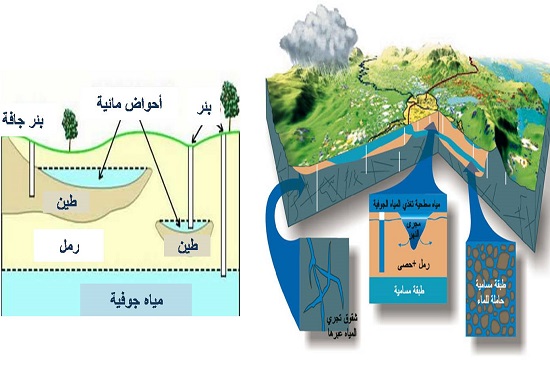| News Details |
Recharge and discharge of groundwater (Naturally recharging and discharging of groundwater)
2022-11-07

Ala’a Yasseen Muhammed - Master's degree in remote sensing - University of Baghdad
Definition of groundwater:
Groundwater is one of the important sources of water that is stored inside the ground in the spaces between sand, soil and rock crumbs. This water forms water layers known as aquifers. in English (Aquifers) It constitutes a reservoir or a basin for water. Groundwater is considered part of the natural water cycle on Earth, as it seeps into the ground when it rains through soil and rock crumbs, and filters through porous rocks to reach an area in which they gather, and the level of the collected water separates between the water-saturated area or the aquifers in English: (Aquifer zone), The unsaturated region or the Vaduz region (Vadose zone)It is a humid area directly below the surface of the earth through which water passes, but it does not fill all the spaces between the rocks and dust, as the water tends to move downward through the unsaturated region until it reaches the saturated region, while in the saturated region the water moves horizontally depending on the water gradient or The gradient of water pressure going from the highest slope to the lowest slope, and some infiltration may this water during its horizontal movement out of the basin to join the waters of the oceans.
Groundwater formation factors:
There are two main factors responsible for the presence of groundwater, which are:
Earth's gravity: where water seeps under the influence of Earth's gravity into the layers of the Earth.
Type of rocks: The type of rocks located under the surface of the earth is considered the biggest factor in the formation of groundwater, as it may be difficult for gravity to influence the water and make it permeate and move down through dense rocks such as solid granite, but the rocks under the surface of the earth vary between sandy rocks, granite and limestone, and differ
Each other in the number of voids that water can gather in, and the voids may increase due to the fracture of the rocks, which gives the water more areas to stay in, and the water may dissolve some rocks such as sandstone, which increases the size of the voids and thus increases the amount of water stored.

Diagram showing the factors of groundwater formation
Recharge and discharge of groundwater:
Groundwater’s recharge and discharge naturally: Groundwater levels vary from season to season, increasing at the end of rainy seasons, and decreasing at the end of dry seasons. Therefore, rainwater is considered the main nutrient for groundwater, and areas with high amounts of precipitation, such as areas near mountain tops, are classified as Groundwater recharge areas compared to the low areas adjacent to it. As for the groundwater discharge, it depends on its depth. A natural discharge of shallow groundwater occurs in valleys and low areas, while deep groundwater discharges into the oceans.
Groundwater recharge and industrial discharge:
Groundwater may be subjected to artificial discharge by humans, so it is pumped from the aquifers in it to meet human needs, and some advanced societies recharge the groundwater basins in ways
artificial to conserve water resources Depending on the geological and hydrological conditions of the aquifer, the water level may drop by tens of meters and persist for long periods, which may lead to the drying up and disappearance of groundwater wells.

Diagram showing the discharge areas of groundwater
Groundwater movement speed of movement:
Groundwater moves continuously, but its movement is slower than the movement of surface water because of the narrow passages in which it passes through pores and voids, its friction with crumbs and rocks, and because it is affected by static electric forces, as its speed is about 0.00002 km / h, while the speed of river flow is about 30 km/h, and the speed of movement of ocean currents is 3 km/h.

Groundwater movement direction chart
Movement direction:
Water usually moves vertically downwards due to the effect of Earth's gravity, and it may move upwards under the influence of pressure difference; It moves from areas of high pressure, such as layers that lie under mountain peaks, to areas of low pressure, such as layers that lie under valleys, just as water moves in a tube in the form of a letter. (U). It decreases on the side that is affected by higher pressure and rises on the other side, and the surface of the earth can be divided according to the movement of groundwater into two parts; They are: Groundwater recharge areas: percolation recharge areas:(recharge areas)The water moves down to the saturated area or the groundwater basin. Groundwater Discharge Zones: These emerge from the groundwater discharge areas (discharge areas)It moves toward the surface to lakes, streams, and springs.
Groundwater pollution:
First: Natural causes: Some impurities are naturally present in water, due to the melting and erosion of part of the rock components when they come into contact with water. The groundwater content of dissolved minerals increases, and some of them may give the water an unacceptable taste or smell, so groundwater is classified as polluted and unfit for drinking when the amount of dissolved minerals increases, or when the water contains manufactured chemicals, and some minerals may cause an increase in groundwater Such as iron, manganese and sulfate has some negative effects, in some regions of the United States of America, such as the Piedmont region (Piedmont) Blue Ridge (Blue Ridge), Iron rust-coloured spots appear on the ceramics of washbasins and bathrooms due to the increase in the iron content in their water, and the sulfate content may rise in the groundwater of areas where coal and natural gas are present, causing an unpleasant smell of water, and groundwater may contain bacteria that have moved to it from the soil, Which may change the taste, smell and colour of the water.
Second: - Human causes: Groundwater is affected by pollutants resulting from human activities, just as surface water is affected and the arrival of these pollutants to the groundwater, but as they continue to accumulate, their quantity gradually increases. Pollutants seep into groundwater aquifers from several sources, including:
Human Waste: Pollutants and bacteria enter the water from sewage systems and landfills near aquifers and wells.
Agricultural activities: Agricultural activities include chemical fertilizers and pesticides used in agricultural lands, which filter along with water to nearby aquifers.
Industrial waste: through the unsafe disposal of waste resulting from industrial activities, such as petroleum materials, detergents and dangerous chemicals.
#university_of_anbar
#Upper_Euphrates_Basin_Developing_Center









